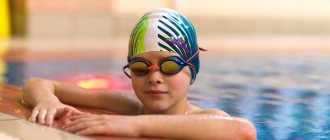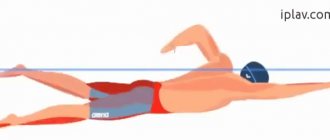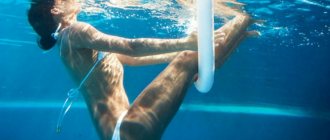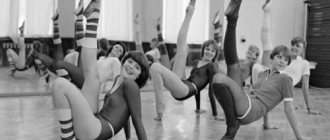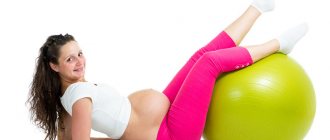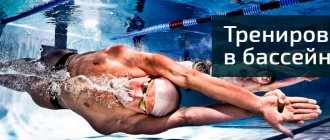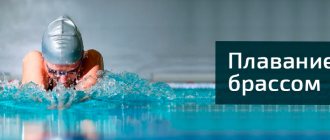Only a stupid person can deny the benefits of swimming, and not so much for the figure, but for the whole body. Many doctors and athletes advise parents to send their child to the pool to strengthen the immune system, normalize the functioning of the body as a whole or an individual organ, be it the heart, liver, kidneys, stomach or even the endocrine system.
And all because water can fill the human body with energy invisible to the naked eye, but so tangible.
Swimming in the pool for weight loss is an excellent alternative to the gym, or even an addition. For example, first exercise on exercise machines, and then a pleasant touch of water to the body. Want to know how swimming affects your figure? Then “sail”!
The benefits of swimming in the pool for the female body
The benefit of swimming in the pool for women is that it is a good means of preventing and treating women's diseases and problems.
The benefits of swimming in the pool for women are undeniable, because it has a beneficial effect on the entire body.
Regular swimming lessons:
- Prevents the occurrence of excess weight, which can provoke diseases of the cardiovascular system, gastrointestinal tract and respiratory system.
- Allows you to get rid of cellulite and make the skin elastic.
- Promotes the formation of correct posture and makes joints flexible.
- Helps lift your mood and relieve stress. Water is an excellent remedy for insomnia.
Who is recommended to use the pool?
Due to the invaluable benefits of swimming, visiting the pool is recommended not only to maintain physical fitness, but also to restore the body:
- Those who want to bring their body back to normal (lose weight, stretch muscles, recover after childbirth, etc.).
- People with poor posture, scoliosis, osteochondrosis.
- Pregnant women, including to relieve uterine tone and reduce the manifestations of toxicosis.
- Patients suffering from diseases of the gastrointestinal tract.
- For men to prevent prostatitis and improve erectile function.
Swimming is a great way to relieve stress, relax and give your body a rest.
For many people, swimming in the pool is practically the only acceptable sport: for example, with varicose veins, joint diseases, arthrosis, osteochondrosis, any serious physical activity (running, jumping, strength exercises), except swimming, is excluded.
Swimming for the spine
Swimming not only helps you relax, but also trains your muscles. For problems with the spine, water is an alternative way to treat and prevent diseases of the musculoskeletal system. In water, the load on the spine is reduced, which makes it possible to perform health-improving exercises without discomfort.
Swimming helps:
- strengthen your back muscles;
- remove pinched nerves and displaced intervertebral discs;
- correct posture, violations of which negatively affect the musculoskeletal and nervous system.
Common problems
Some beginners face some problems due to which many people quit swimming.
Problem 1: Swimming is boring.
Try to add variety, you don’t need to constantly swim only in circles. The most effective solution is to swim vertically, this way you will receive 75 percent more resistance, and thereby better influence your muscles.
In addition, you can visit water aerobics. This is swimming to certain music. During this workout, the whole body is involved.
The third option to diversify your swimming and lose more excess weight is to walk in the water.
Problem 2: Eye irritation.
This can happen due to chlorine water getting into your eyes. To avoid this problem, use special glasses for the pool.
Problem 3: hair deteriorates.
Buy a special hat. Of course, such an attribute will not retain all the water, but it will help keep your hair dry. Chlorinated water has a negative effect on skin and hair.
Problem 4: getting tired quickly.
Most beginners do not know how to distribute their strength in the pool. They swim a couple of laps at an accelerated pace, run out of steam, get tired and end their swim. To avoid this problem, it is recommended to alternate training with rest. To start, try this: 30 seconds of swimming, 30 seconds of rest. Gradually increase your workout time without rest.
Strengthening the cardiovascular system
Swimming also has a good effect on the cardiovascular system. It normalizes metabolism and improves endurance.
Benefits from classes:
- During exercises in the pool, the swimmer is in a horizontal position. In this state, it is easier for the heart to pump out blood.
- When swimming, a person breathes deeply, and the muscles actively work. This allows you to remove stagnation of blood and lymph in the vessels.
- Swimming normalizes blood pressure.
- During swimming, the functioning of the heart improves and the likelihood of premature wear and tear is reduced.
Don't miss the most popular article in the section: Laser hair removal on the face and body - how it is done, effectiveness, before and after photos, contraindications.
Reviews
Most visitors note the positive effect of visiting the pool for weight loss. Some are concerned about the increased danger of water activities to health and life.
Some people are confused by the presence of microbes in water. Many people claim that swimming relieves stress, increases energy levels and improves muscle tone.
Forum readers tend to think that intense swimming has an effect on weight loss, provided that they practice several times a week and follow proper nutrition.
According to one reader, swimming with your head up increases the risk of osteochondrosis. According to the reader, who has been swimming all her life, swimming is an indispensable assistant in the fight against obesity caused by physical inactivity.
Reviews can be found on the forum and on Aircomend.
Swimming in a physiotherapy treatment program
Swimming increases the therapeutic and preventive benefits of physiotherapy, allowing you to achieve better results in the treatment of diseases. Swimming in the pool is prescribed before many physiotherapeutic procedures to promote better penetration of medications into the body.
And swimming prescribed after physiotherapy helps maintain the effect of medications on the body.
Indications for visiting the pool together with physiotherapy:
- problems with the spine;
- diseases of the musculoskeletal system;
- hernia;
- cardiovascular diseases;
- problems with excess weight;
- diseases of the respiratory system.
How to eat and drink properly to avoid gaining weight
Exercising alone is not enough to lose weight. The most important element in losing weight is reducing the calorie content of consumed foods. The best option is to develop a full menu by a nutritionist, taking into account the characteristics of the body and the tests and studies performed.
If this is not possible, you need to take the following steps to organize meals:
- Calculation per kilogram of weight and inclusion of protein products in the diet.
- Eating fresh vegetables daily.
- Reducing or eliminating sweets, fatty and fried foods from the diet.
- Supplement the menu with a small amount of nuts and seeds.
- Consumption of unrefined vegetable oils.
- Calculation of cereals, depending on weight.
The lion's share of calories in the daily diet comes from carbonated drinks, sweet tea and coffee. If you replace most of these drinks with plain clean water, you can improve metabolic processes in the body.
Reducing the risk of diabetes by swimming
People suffering from diabetes should not give up physical activity.
Benefits from classes:
- Swimming helps control weight.
- Exercises in the pool have a beneficial effect on the heart and blood vessels, enriching the body with oxygen.
- Swimming uses all muscle groups. As a result, they actively use glucose, reducing its concentration in the blood.
To avoid changes in blood sugar levels, you should always carry medications and a medical bracelet with you.
After swimming, you often feel hungry, so you should take foods allowed for snacking with you to training.
Necessary equipment to attend classes
Beginners to swimming will need to purchase a full set of equipment for classes. Usually the following items are enough for the first couples :
Swimming goggles are an indispensable accessory for underwater swimming. It is important to make sure that the model does not leak liquid.- Earplugs will protect your ears from water.
- Swimsuit – should be chosen according to the degree of comfort.
A good model should not press, rub or slip. Indoor sports options are suitable for swimming pool activities. - Cap. Experts say that there is no difference in swimming caps of different brands and prices. Here it is important to build on the comfort of the product.
- Rubber slippers with an anti-slip effect will ensure safety.
- Flippers are an additional piece of equipment, but they provide a huge advantage when losing weight, since they increase the load on the hips and legs several times. The abdominal and waist area is also reduced when using fins.
If you wish, you can limit yourself to an ordinary swimsuit, hat and flip-flops, but accessories such as glasses and earplugs will help maintain good health.
Recommendation! The optimal time for swimming is in the morning before 9.00 and in the evening after 18.00. At this time, the body is more susceptible to burning calories.
The benefits of swimming for your figure
The benefits of swimming in the pool for women are due to the fact that many muscle groups are involved, which has a great effect on the figure:
- waist size decreases;
- the inner thighs are tightened;
- manifestations of cellulite are reduced;
- the muscles of the shoulder girdle are strengthened, which helps improve posture;
- The muscles of the chest develop, as a result of which it becomes more elastic.
After giving birth, a woman can improve her figure by visiting the pool 2-3 times a week.
Workout
As already mentioned, you will need a comprehensive program for swimming in a pool for weight loss, which you will either need to find and adapt for yourself, or call an experienced trainer for help.
If you already have good skills in this sport, most likely you will be offered so-called interval training, which is considered the best option for anyone who wants to lose weight and shape their figure.
Interval training (for those who are good swimmers)
Swimming interval training for weight loss, when done correctly, can burn almost 10 times more calories than aerobic exercise over the same time interval. You shouldn’t start them on your own, because this is a serious burden on many organs. In addition, they are suitable only for those who can swim very well and feel like a fish in the water.
Consult with a trainer, try to objectively assess your capabilities - and only then proceed to implement them using the following method:
- Do a 10-minute warm-up on dry land.
- Swim in the pool for 10 minutes in different styles - also as a warm-up.
- Within 30 seconds, squeeze 90% of your strength and swim butterfly.
- The next 30 seconds is a rest, when you need to swim breaststroke at a calm pace.
- For 1 lesson, repeat from 5 to 7 cycles, if possible.
- There should be no more strength left for the last cycle.
- Over time, the body will train and at the end of the last interval there will be enough strength left. This is a signal to increase the active swimming phase and shorten the rest phase by the same amount of time.
- Classes are held every other day (or every 2) three times a week.
- The weight loss course is 3 weeks, then an interval of 2 months and a return to exercise.
This is the swimming technique for losing weight using interval training. Such activities are very exhausting, require a certain amount of physical training, but at the same time they sharpen the figure and make the muscles more prominent and beautiful. With such a correction, there is no need to be afraid of anorexia or dystrophy.
But what should those who cannot swim so well and are not ready for such grueling loads do?
Average fitness level
Often a person can swim well, but his level of physical fitness does not allow him to perform interval training. For weight loss, we can recommend a more simplified exercise regimen:
- 10 minutes warm-up on dry land.
- 15 minutes of calm swimming to get your body used to the water.
- Holding a board (ball) in your hands, swim 200 m using only your legs.
- On the way back, hold the same equipment (ball, board) with your feet and swim the same distance using only your hands.
- Swim in one direction as quickly as possible, and in the other as slowly as possible. Perform in the same style. Do 4-5 times.
- Relax. Float on your back for a few minutes.
Typically, this technique of losing weight through swimming is chosen by overweight people who find it difficult to perform too intense exercise.
Beginners
Some people specifically learn to swim in order to lose weight. And not in vain. After all, they also have a whole program of exercises to combat excess weight. At first they should last no more than 30 minutes, but gradually, as the body gets used to the water, they are increased to 1 hour. Training scheme:
- 5 minutes warm-up on dry land.
- The same amount is in the water.
- 5 minutes - crawl.
- 5 minutes rest.
- 5 minutes - breaststroke.
- 5 minutes rest.
- 5 minutes - on your back.
- 5 minutes rest.
If you set yourself a goal to lose weight through swimming, you can only do this if you approach the matter competently. These training programs are indicative. Usually trainers adjust them taking into account the individual characteristics of the client.
In particular, you need to be able to choose the right swimming style for your body. After all, each of them works in priority on a certain area of the body.
Wow! In water, the mass of the human body decreases by as much as 10 times. If only it were the same with weight!
Effect on muscles
During swimming, the muscles alternately tense and relax, which allows them to become stronger. The muscles of the shoulder girdle, legs and arms are the most tense. Swimming styles develop different muscle groups.
Therefore, when choosing a technique, you can choose which muscles the swimmer wants to strengthen more:
- during breaststroke, the back and hips are actively involved;
- During butterfly swimming, the muscles of the abs, arms and legs are tensed. The oblique muscles on the abdomen also develop;
- if a person swims freestyle, the load goes to the latissimus muscles of the back and arms;
- When swimming on your back, the muscles of your back and abdomen work most actively;
- When crawling, almost all muscles are involved, but a large load falls on the shoulders.
The best option is to alternate styles. It will strengthen the muscles of the whole body.
How to exercise to lose weight while swimming?
Before starting a full workout, instructors suggest doing a short warm-up.
This could be running in place in the water, jumping or pushing off the side. It is important to warm up your muscles before starting a set of exercises. Some exercises can be done independently, but more complex elements should only be done under the supervision of a water aerobics trainer.
Hand exercises
Options:
- Breaststroke swimming is the best option for training arm muscles. To achieve maximum effect, you need to combine a fast and smooth pace of movement;
- alternating breaststroke and crawl;
- use of blades;
- the use of a kolobaska, which must be held between the legs to increase the load on the arms.
Leg workout
Leg training begins with warm-up exercises:
- abduction and extension of legs;
- swing your legs;
- bending the legs at the knees;
- jumping on both legs;
- Steps.
Basic leg workout:
- cross type of steps;
- high jump on the spot;
- stretching in the water or on the sides.
Each exercise must be performed at least 20 times.
Strengthening the buttocks
Training the buttocks and thighs is a multi-step process.
The first stage - the water should reach chest level:
- connecting arms and legs crosswise;
- alternately raising your arms up in a jump.
The second stage is 20-minute steps in place.
The final stage:
- leaning on the side, swing your legs;
- bending the legs towards the buttocks;
- scissors and bicycle exercise.
Reference! In between training sessions, you can swim as usual.
Abdomen area
Losing weight in the abdominal area requires an integrated approach, with a combination of elements of water aerobics, exercises for the waist and abs, and aqua fitness.
Aquafitness:
- jogging;
- tremors;
- swimming without arms on your back.
Water aerobics:
- touching the toes of the palms while jumping under water;
- jumping with legs spreading and closing;
- pulling the legs in a lying position to the chest area.
Swimming for weight loss
The benefits of swimming in the pool for women are due to the fact that water exercises speed up metabolism, which promotes weight loss. In 60 minutes of active swimming, a woman burns about 400-500 calories. This is almost 2 times more than when doing fitness or exercising on machines.
Swimming not only helps you lose weight, but also helps increase your endurance. Unlike, for example, running, this sport reduces the load on the spine and joints, which is its advantage when choosing physical activity for weight loss.
To increase the effectiveness of your training, it is recommended to learn different swimming techniques. This will help you work out different muscles as much as possible. The temperature in the pool should not exceed 28 °C - more energy is spent in cool water, so the body will expend more calories to heat the body.
To achieve results, you need to visit the pool 3-4 times a week. However, losing weight is a long and painstaking process that requires an integrated approach.
Rules for exercising in the pool for the purpose of losing weight
To fully benefit your figure from swimming in the pool, you need to:
- Try to stay afloat throughout the workout so that the body is constantly under tension and burns more calories. There is no need to hold on to any support. Breaks are taken only when you are very tired or have poor swimming technique. They should be short-term and not frequent.
- Classes should last at least half an hour, and their number during the week should be at least two.
- It is necessary to move actively throughout the entire session, since the benefits of the pool for consuming fat tissue will only be noticeable at a heart rate of 130 - 160 beats/min. In this case, you can consume up to 1,300 kilocalories per hour. To increase motor activity, choose butterfly. If it is difficult for you, then give preference to the less energy-consuming rabbit.
- Try to change swimming styles every 5 minutes.
- You should not eat food immediately after class. Then the body will burn fat by inertia for a long time.
The effect of swimming on mood
Swimming promotes relaxation and helps relieve stress. Exercising in the evening eliminates fatigue accumulated during the day and helps improve sleep patterns.
While swimming, endorphins (hormones of joy and pleasure) are produced in the brain, which improve mood and increase performance.
Exercises
If you need to lose weight in a specific part of the body that suffers from fat deposits, choose a special set of exercises for swimming. For each visit to the pool you need to complete 5 approaches. Start with 10 times in 1 approach, gradually increasing this number.
The maximum number is 100. A sign that you are doing everything right is the tension in the area that you want to correct.
Legs
- If you need swimming to lose weight in your legs, swing them right in the water.
- Walking in water with arms extended forward and knees raised high. Try to speed up from time to time.
- Legs together, arms at sides. Spread your legs to the sides, at the same time bring your arms together.
Waist, sides
- Lie on your back.
- Hands to the sides.
- Exhale deeply.
- Stretch your knees towards your chest.
- Inhale.
- Lower your legs.
- This exercise is called “Ballerina”, and it is best used to lose belly fat in water.
Hands
- Hold the ball with your feet and swim using only your arms.
- Do the scissors exercise with your arms extended forward in the water.
- Butterfly is the best swimming for losing weight in your arms.
There are different sets of exercises to perform in water for the purpose of losing weight. You need to look for one that will be effective for your body. A coach and a worldwide network can help.
At the same time, do not forget that swimming has its own nuances that can prevent you from losing excess weight. You need to be able to avoid them.
This applies to exercises on the water. For those who want to do additional exercise outside the pool, we recommend that you familiarize yourself with the exercises for losing weight of the same parts of the body, only at home or in the gym: “Exercises for losing weight on the abdomen and sides” and “Exercises for losing weight on the arms and shoulders.”
Keep in mind. Swimming is an excellent solution if other sports are contraindicated due to joint problems, back problems, obesity or pregnancy.
How does swimming affect your immune system?
The pool is an excellent means of preventing colds. Training helps strengthen the immune system and improve blood flow, and the temperature difference between water and air adapts the body to changes in the environment, hardening the body.
To prevent colds while visiting the pool, you should adhere to the following recommendations:
- You need to move vigorously in the water to avoid freezing.
- In order for the body to get used to temperature changes, the first visits to the pool should be limited to 20-25 minutes. Gradually the time can be increased to an hour.
- After swimming, you need to dry yourself well and dry your hair.
Don't miss the most popular article in the section: Morning exercises for those over 40, 50. Gymnastics exercises for weight loss, video lessons.
Basic mistakes of newbies
It often happens that beginners who decide to take up swimming to lose weight make a bunch of mistakes. To avoid them, study the following rules.
- The 45-minute workout means you'll be doing more than 80 percent of your workout in the water.
- Before you go into the water, do a little warm-up.
- If you can swim 600 meters without much effort, then know that simply swimming will not have an effect on losing weight. Do aqua yoga or aqua aerobics.
- Classes should be carried out in water whose temperature is not less than +26 and not more than +28 degrees. If the water is less than +26C, then forget about the training time, swim until you freeze.
Swimming in the pool during pregnancy
Swimming in the pool is one of the healthiest activities for pregnant women.
It is advisable to start swimming lessons after the 12th week, and can continue until the end of pregnancy.
Swimming has a positive effect on the well-being of mother and child. If the fetus is not presented correctly, a woman can perform special exercises in the pool that will help change the baby’s position from pelvic to cephalic.
Benefits from classes:
- In water, the back muscles relax and the load on the spine decreases. This helps get rid of lower back pain.
- Exercising in the pool allows the expectant mother to prepare for childbirth. While swimming, the woman begins to breathe deeper.
- Air retention during diving also prepares the child for childbirth, during which the supply of oxygen to the fetus decreases.
- Swimming is an excellent way to prevent extra pounds, which add stress to the expectant mother’s body.
- Exercise has a positive effect on the cardiovascular system. The pregnant woman's blood pressure normalizes and swelling goes away.
- In the water, a woman calms down and forgets about her problems. As a result, her mood improves.
Before going to the pool, you should definitely consult a gynecologist.
Recommendations:
- If a woman does not know how to swim, she can simply walk in the water or do useful exercises.
- While swimming you need to breathe properly. A pregnant woman should not swim fast; it is better to choose a moderate pace. It is necessary to take breaks during classes.
- The water in the pool should not be colder than 30 °C. A pregnant woman can spend no more than 25-30 minutes in water.
Swimming and water aerobics: contraindications
Everyone can swim, it is even necessary, not a single doctor will prohibit his patient from doing so. The only thing is that there may be restrictions on load and time, which the doctor or trainer will tell you about. But water aerobics has a contraindication - bronchial asthma.
Those who have been diagnosed with cervical osteochondrosis and damaged eardrums should approach this sport with caution. Since there are now few swimming pools left where the water is chlorinated, allergy sufferers can rest assured, but it is better to check this with the staff of the sports center.
How to swim in the pool correctly
Proper breathing plays an important role while swimming. You need to breathe through your mouth, not through your nose. To achieve better results, it is better to use all styles alternately - then the load will be evenly distributed across all muscle groups. Don't forget about breaks between classes, which are an important element of a successful workout.
There are 5 basic swimming techniques:
- freestyle;
- crawl;
- butterfly;
- breaststroke;
- backstroke.
Some people are fluent in all styles, while others prefer a certain swimming technique.
Breaststroke technique
The breaststroke technique resembles the movements of a frog in water. Hands move from the chest and back, cutting through the surface of the water. The palms should be straight and the fingers should be closed. Swimming speed depends on the movement of the legs. The stronger the push, the higher the speed of sliding through the water. Inhalation is carried out through the mouth while raising the head. Exhalation is done under water.
Breaststroke requires the least amount of effort, but is the slowest swimming style.
Backstroke
When swimming on your back, unlike other strokes, you can take in air at any time. The hands are in opposite directions, replacing each other: one at the bottom along the body, the other at the top behind the head. The work of the hands resembles the movement of a mill. The legs move up and down due to the force exerted by the thigh muscles.
How to swim crawl
The fastest swimming style. The technique of crawl swimming is similar to backstroke swimming. Only the starting position is different: the swimmer is on his chest. The actions of the upper and lower extremities complement each other, which makes it possible to develop high speed.
During the slide, the body turns slightly so that the swimmer can inhale air. The head looks down, and when inhaling, it looks to the side.
Butterfly
Butterfly is one of the most difficult and tiring swimming strokes. The arms move in a sweeping manner, like the wings of a butterfly.
The legs perform a wave-like movement. The actions of the lower extremities allow the chest to be lifted above the water.
Necessary equipment
Are you determined to lose weight through swimming? Well, this is commendable, but first, go to a sports store and purchase the necessary equipment for exercise.
Simple and very inexpensive equipment will make going to the pool a real holiday, will make you feel like a professional, and most importantly, will also actively participate in the fight against excess weight.
- Glasses
The most important criterion when choosing swimming goggles is tightness, i.e. the ability to keep water out.
- Swimsuit
For active swimming, a woman will need a practical, comfortable swimsuit. It shouldn't rub anywhere and you shouldn't be constantly afraid of losing it. It is better to give preference to a one-piece model, which should match your size.
- cap
There is no need to throw money away buying a swimming cap. In terms of functionality, they are all the same - there is no fundamental difference in the models.
- Slippers
Non-slip soles are the main criterion for choosing slippers in which you will get to the pool.
- Flippers
Perhaps the only sports equipment that somehow contributes to weight loss. After all, swimming with fins increases the load on your legs and makes you lose weight more actively in your waist and sides.
Specifically for training in the pool and exercises in the water, you do not need any specialized equipment. But many people ignore the above things, believing that they do not play any role in losing weight.
And only a few understand that without them, while swimming, there is a risk of contracting an infection, getting conjunctivitis, slipping and getting injured. And all these circumstances will keep you away from classes for a long time, and accordingly, you won’t be able to say goodbye to excess weight either.
On a note. The best time for swimming is 7-9 and 18-20 hours. In the morning, the body is relaxed and very susceptible to this kind of stress. In the evening, this sport can burn maximum calories.
Which swimming style to choose
| Crawl |
|
| Backstroke |
|
| Breaststroke |
|
| Butterfly | This style requires the most energy, which contributes to effective weight loss. |
Swimming in a pool or in reservoirs is extremely beneficial for the female body, as it strengthens not only the muscles, but also allows you to get your figure in order. It has a beneficial effect on the cardiovascular, musculoskeletal, and respiratory systems, improves mood and improves immunity, and helps prevent chronic diseases.
Author: Julia Winters
Article design: Oksana Grivina
What are the benefits of a swimming pool?
When a person swims or exercises in water, his body is subjected to complex stress. Not only specific muscle groups “take part” in the training, but also life support systems (lungs, heart, etc.), as well as bones and joints.
The benefits of a swimming pool for your figure are also undeniable, since the rate of calorie consumption is higher compared to the same workouts in the fitness room. Exercising in water does not help to increase muscles, but to strengthen them. First of all, this applies to the abdominal muscles, abdomen and buttocks. The joints also become more flexible.
The pool is also useful for people with poor health who are not suitable for regular workouts in the gym.
Development of flexibility and unloading of the musculoskeletal system
Stretching before and after workouts helps increase the flexibility of your legs, arms, hips, and neck, especially if this happens in conjunction with swimming. There is also an improvement in posture and back pain disappears.
As you know, in water a person becomes 90% lighter. Thanks to this, the musculoskeletal system is unloaded. Exercises on the water take place in a horizontal position, which, in turn, reduces the load on the joints and spine to zero. It is impossible to achieve such high results on land as in water. This is the main advantage over other sports. In water, the spine stretches, and at this time the vertebrae take their places. If a person has back problems, doctors advise swimming, especially as a means of rehabilitation after injuries.
If you count all the movements made in the water, they significantly exceed the figures made on land. This work of the joints helps strengthen the musculoskeletal system. Circular movements of the arms made in the water strengthen the shoulders, and movements with the legs strengthen the pelvis. Training in water will help you forget about flat feet, because your legs move regularly, which helps strengthen your feet.
